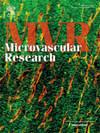Focal adhesion kinase mediates microvascular leakage and endothelial barrier dysfunction in ischemia-reperfusion injury
IF 2.7
4区 医学
Q2 PERIPHERAL VASCULAR DISEASE
引用次数: 0
Abstract
Intestinal ischemia-reperfusion (I/R) injury occurs under various surgical or disease conditions, where tissue hypoxia followed by reoxygenation results in the production of oxygen radicals and inflammatory mediators. These substances can target the endothelial barrier, leading to microvascular leakage. In this study, we induced intestinal I/R injury in mice by occluding the superior mesenteric artery, followed by removing the clamp to resume blood circulation. We assessed microvascular permeability to plasma proteins in vivo using intravital microscopy, measuring the time-dependent tracer distribution in the intravascular versus extravascular space in the mouse mesentery. Additionally, we examined endothelial cell-cell adhesive barrier resistance and junction morphology in cultured endothelial cell monolayers. At the molecular level, FAK inhibition similarly inhibited endothelial junction opening and barrier dysfunction in response to hydrogen peroxide-induced oxidative stress. To further investigate FAK's role with tissue/cell specificity, we developed an endothelial-specific inducible FAK knockout mouse model by crossbreeding FAK-floxed (FAKfl/fl) mice with Tie-2-CreERT2 transgenic mice. Compared to their wild-type controls, endothelial-specific FAK-deficient mice showed a blunted microvascular hyperpermeability response following I/R injury in the gut. Overall, our study demonstrates that FAK plays a significant signaling role in mediating endothelial barrier dysfunction and microvascular leakage during ischemia-reperfusion injury.
局灶黏附激酶介导缺血再灌注损伤微血管渗漏和内皮屏障功能障碍。
肠缺血-再灌注(I/R)损伤发生在各种手术或疾病条件下,组织缺氧后再氧化导致氧自由基和炎症介质的产生。这些物质可以靶向内皮屏障,导致微血管渗漏。在本研究中,我们通过闭塞肠系膜上动脉诱导小鼠肠I/R损伤,然后移除夹子以恢复血液循环。我们使用活体显微镜评估了体内微血管对血浆蛋白的渗透性,测量了小鼠肠系膜血管内和血管外空间的时间依赖性示踪剂分布。此外,我们在培养的内皮细胞单层中检测了内皮细胞-细胞粘附屏障阻力和连接形态。在分子水平上,FAK抑制类似地抑制内皮连接开放和屏障功能障碍,以响应过氧化氢诱导的氧化应激。为了进一步研究FAK在组织/细胞特异性中的作用,我们通过将FAK-floxed (FAKfl/fl)小鼠与Tie-2-CreERT2转基因小鼠杂交,建立了内皮特异性诱导FAK敲除小鼠模型。与野生型对照相比,内皮特异性fak缺陷小鼠在肠道I/R损伤后表现出迟钝的微血管高通透性反应。总之,我们的研究表明,在缺血再灌注损伤过程中,FAK在介导内皮屏障功能障碍和微血管渗漏中起着重要的信号传导作用。
本文章由计算机程序翻译,如有差异,请以英文原文为准。
求助全文
约1分钟内获得全文
求助全文
来源期刊

Microvascular research
医学-外周血管病
CiteScore
6.00
自引率
3.20%
发文量
158
审稿时长
43 days
期刊介绍:
Microvascular Research is dedicated to the dissemination of fundamental information related to the microvascular field. Full-length articles presenting the results of original research and brief communications are featured.
Research Areas include:
• Angiogenesis
• Biochemistry
• Bioengineering
• Biomathematics
• Biophysics
• Cancer
• Circulatory homeostasis
• Comparative physiology
• Drug delivery
• Neuropharmacology
• Microvascular pathology
• Rheology
• Tissue Engineering.
 求助内容:
求助内容: 应助结果提醒方式:
应助结果提醒方式:


